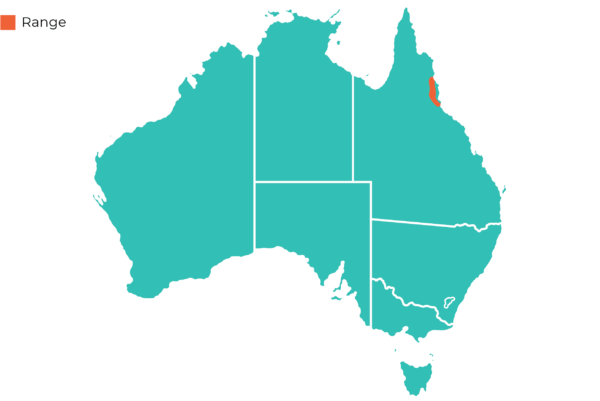Description
The Lumholtz Tree Kangaroo is the smallest of the 14 tree kangaroo species. They’re from the same family as our famous kangaroos but unlike their larger relatives, they can move their legs independently.
The Lumholtz Tree Kangaroo climbs a tree by gripping the trunk or branch with its forelimbs and then pushing up with the hindlimbs (moving in reverse, tail-first, when descending). Nearing the ground, a tree kangaroo will release its hold on the trunk and kick off with its hindlegs and land on the rainforest floor and hop away.
Distribution
The Lumholtz Tree Kangaroo is endemic to the wet tropics in Far North Queensland, Australia. The Lumholtz Tree Kangaroo is found in the rainforest of tropical Queensland, centred on the Atherton Tablelands, extending north as far as the Carbine Tableland, where the distribution of the Bennett’s Tree Kangaroo begins.

Lifespan
15 years.
This animal is listed on the IUCN as Near Threatened.
Size
Males weigh an average of 7.2kgs and females 5.9kgs. Their head and body length range from 48 – 65cm and their tail 60 – 74cm.
Habitat
Mainly found at high elevations in upland rainforests.
The original preferred habitat of the Lumholtz Tree Kangaroo was the coastal lowland rainforest. However, it is now more common at higher altitudes above 300 m due to the clearing of lowland habitats.
Diet
They are herbivorous (folivorous) animals and consume leaves of more than 37 plant species including trees, vines, shrubs, epiphytes and flowers.
Breeding
The Lumholtz Tree Kangaroo does not appear to have a definite breeding season. Sexual maturity occurs in males at about 4.5 years of age, and in females as early as 2 years. Males “court” females by uttering a soft clucking sound and softly pawing her head and shoulders. When the female moves away the male follows, pawing at the base of her tail.
Following mating, there is a gestation period of 42 – 48 days which is the longest known gestation of any marsupial. The female gives birth to a single joey which attaches to a teat in the pouch (the teat becomes enlarged prior to birth). The joey lives in the pouch of its mother and doesn’t start coming out until the age of about 250 days.
树袋鼠 | ラムホルツのツリーカンガルー | 럼홀츠트리 캥거루